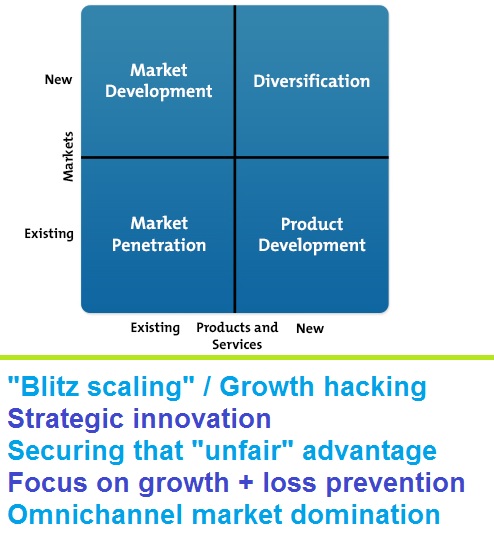We are mostly familiar with the shift in thinking towards browth hacking or “blitz scaling”. However these techniques are best when used as an additional tactic for the business and should not be the basis for an overall strategy. Yes, rapid growth through viral email and social sign-up technology is where the profession of “chief marketing officer” and “chief technology officer” converge and we would consider such an approach useful as part of the digital marketing strategy. In this article I’d like to share with you ways in which a marketing consultant can help you secure sustainable business growth in competitive markets.
The level of thinking required here is that we take an overall view on the business and it’s market position, without picking just one successful tactic. It does not matter whether you’d like to grow your revenue by 200% or just reposition yourself for the future, there is still a particular sequence we’d use to explore your options.
Let’s first consider the traditional thinking behind business growth by reference to the “ansoff matrix” below:
Regardless of whether we look at our digital, conventional or offline sales & marketing marketing channels, there are four quadrants in which we consider business growth. Many businesses are in a safer position when they develop more than one quadrant.
Now if we explore the quadrants of the Ansoff Matrix and build on the principles superfically:
| Market Development | Diversification |
|---|---|
Here, we would typically target new markets, or new areas of your existing market. The aim is to sell more of the same things to different people. Options would include:
|
|
| Market Penetration | Product Development |
With scale, connections and presence, one should opt for maximum returns within an existing market.
|
Here, you’re selling different products to the same people, so you might:
|
Now that we’ve discussed the four traditional methods of business development, one should ask the question:
Where does YOUR business fit in? Can we identify ways in which to grow, diversify, penetrate and develop?
I love to use case studies of how other businesses used various quadrants to grow – and then critically analyse the business of my client in relation to that. The deep understanding of the client about their own business, coupled with my insight on multiple business models and the latest digital innovation makes for a good discussion or brainstorming session. Typically, once we considered all the business development quadrants we can then apply ways in which we know the business development is more sustainable. There are numerous ways, however today I will list five such ways:
- The business should have multiple strategic benefits:
Often, advantage is only temporary. Once the competition caught up, you cannot stay ahead by stating “We were the first company to have done this”. The clients simply do not care who were first – all that matters, is that TODAY, everyone is doing it, so now it comes down to other actual and perceived benefits. A company with multiple strategic benefits will augment the product or service in such a way that it makes the competition irrelevant to the client.
- The business should have a cost advantage – or people advantage:
Offering a more affordable solution in a competitive market can be effective – however in the luxury segment or other areas such as health and innovation, it is not about saving money – but about the ultimate outcome required by the customer. In the knowledge economies of today, people is the differentiating factor – and if we say “people” we actually include “technology” since people are also responsible for operating technology. How can you attract and retain the best people, as part of your strategy to be a market leader?
- Speed of innovation VS scale
In working with many SME type clients, it is not their scale that helps them since they are smaller, but the speed at which they adapt. They take advantage of their streamlined approach – and whilst larger corporations are still trying to assess the impact and getting everyone’s agreement, the fast moving client demonstrated leadership as a first mover. This often helps to obtain free press, viral marketing and other benefits which larger organizations miss out on.
- Owned media VS bought media
One of the most sustainable tactics we use is to enable clients to own the media that promotes their business. For example, I help clients to buy websites and digital assets that would be equivalent to 1 year’s advertising bill, which means that for the next 5ot 8 years, they never pay again for their online advertising, whereas all their new competitors have to pay Google and Facebook to get into the race. This sustainable tactics also raises a huge barrier of protection for the business and I am proud to be an advocate of this tactic and an expert in the field.
- Building social capital, corporate culture and CRM:
The social capital and goodwill that the business accumulates over time is rather similar to “owned media”, however many CEO’s do not understand that re-engaging existing clients is 14 times more affordable than acquiring new ones. Therefore, fixing “leaky buckets” in an organization should include looking closely at the CRM systems responsible for keeping our clients on board. From this position onwards, we experience “C2C” marketing (consumer to consumer marketing) where our social goodwill drives the business and integrates with our corporate culture.
There are many more tactics we implement over time to ensure sustainable growth. If you’d like to work with a marketing consultant to ensure the best desired outcome, you can reach out here.
You may also want to read through some of our recent case studies which discuss the way in which we helped business in Finance, Medical, Tourism, Luxury, B2B, education and other sectors to grow significantly.
